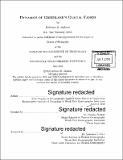| dc.contributor.advisor | Fiamma Straneo. | en_US |
| dc.contributor.author | Jackson, Rebecca H. (Rebecca Harding) | en_US |
| dc.contributor.other | Woods Hole Oceanographic Institution. | en_US |
| dc.coverage.spatial | n-gl--- | en_US |
| dc.date.accessioned | 2016-09-30T19:37:00Z | |
| dc.date.available | 2016-09-30T19:37:00Z | |
| dc.date.copyright | 2016 | en_US |
| dc.date.issued | 2016 | en_US |
| dc.identifier.uri | http://hdl.handle.net/1721.1/104586 | |
| dc.description | Thesis: Ph. D., Joint Program in Oceanography/Applied Ocean Science and Engineering (Massachusetts Institute of Technology, Department of Earth, Atmospheric, and Planetary Sciences; and the Woods Hole Oceanographic Institution), 2016. | en_US |
| dc.description | Cataloged from PDF version of thesis. | en_US |
| dc.description | Includes bibliographical references (pages 165-172). | en_US |
| dc.description.abstract | Glacial fjords form conduits between glaciers of the Greenland Ice Sheet and the North Atlantic. They are the gateways for importing oceanic heat to melt ice and for exporting meltwater into the ocean. Submarine melting in fjords has been implicated as a driver of recent glacier acceleration; however, there are no direct measurements of this melting, and little is known about the fjord processes that modulate melt rates. Combining observations, theory, and modeling, this thesis investigates the circulation, heat transport, and meltwater export in glacial fjords. While most recent studies focus on glacial buoyancy forcing, there are other drivers - e.g. tides, local wind, shelf variability - that can be important for fjord circulation. Using moored records from two major Greenlandic fjords, shelf forcing (from shelf density fluctuations) is found to dominate the fjord circulation, driving rapid exchange with the shelf and large heat content variability near the glacier. Contrary to the conventional paradigm, these flows mask any glacier-driven circulation in the non-summer months. During the summer, when shelf forcing is reduced and freshwater forcing peaks, a mean exchange flow transports warm Atlantic-origin water towards the glacier and exports glacial meltwater. Many recent studies have inferred submarine melt rates from oceanic heat transport, but the fjord budgets that underlie this method have been overlooked. Building on estuarine studies of salt fluxes, this thesis presents a new framework for assessing glacial fjord budgets and revised equations for inferring meltwater fluxes. Two different seasonal regimes are found in the heat/salt budgets for Sermilik Fjord, and the results provide the first time-series of submarine meltwater and subglacial discharge fluxes into a glacial fjord. Finally, building on the observations, ROMS numerical simulations and two analytical models are used to investigate the dynamics of shelf-driven flows and their importance relative to local wind forcing across the parameter space of Greenland's fjords. The fjord response is found to vary primarily with the width relative to the deformation radius and the fjord adjustment timescale relative to the forcing timescale. Understanding these modes of circulation is a step towards accurate modeling of ocean-glacier interactions. | en_US |
| dc.description.statementofresponsibility | by Rebecca H. Jackson. | en_US |
| dc.format.extent | 172 pages | en_US |
| dc.language.iso | eng | en_US |
| dc.publisher | Massachusetts Institute of Technology | en_US |
| dc.rights | M.I.T. theses are protected by copyright. They may be viewed from this source for any purpose, but reproduction or distribution in any format is prohibited without written permission. See provided URL for inquiries about permission. | en_US |
| dc.rights.uri | http://dspace.mit.edu/handle/1721.1/7582 | en_US |
| dc.subject | Joint Program in Oceanography/Applied Ocean Science and Engineering. | en_US |
| dc.subject | Earth, Atmospheric, and Planetary Sciences. | en_US |
| dc.subject | Woods Hole Oceanographic Institution. | en_US |
| dc.title | Dynamics of Greenland's glacial fjords | en_US |
| dc.type | Thesis | en_US |
| dc.description.degree | Ph. D. | en_US |
| dc.contributor.department | Joint Program in Oceanography/Applied Ocean Science and Engineering | en_US |
| dc.contributor.department | Woods Hole Oceanographic Institution | en_US |
| dc.contributor.department | Massachusetts Institute of Technology. Department of Earth, Atmospheric, and Planetary Sciences | |
| dc.identifier.oclc | 958825879 | en_US |
